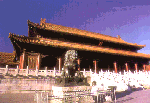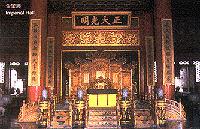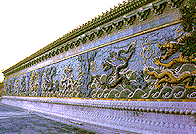Construction of the Palace commenced in 1406, during the Ming Dynasty and was completed in 1420. From completion to now, for over 570 years, the palace endures turmoil rises and falls of dynasties.
In 1420, Ming emperor Zhu Di moved the capital from Nanjing to Beijing-formerly known as Peking. In 1911 civil revolution led to abdication of the last emperor of the Qing Dynasty. For over a period of 491 years, the Forbidden City remains to be the capital for 14 Ming emperors and 10 Qing emperors. It has been a symbol of feudalism and the center of power.
 The palace occupies an area of some 720,000 square-meter with over 9,000 rooms. Historical records showed that it took up to one million laborers and 100,000 artisans to complete the construction project. Original construction materials came from all parts of the country. in the Ming Dy-nasty, the timber needed for building the palace was brought mostly from Sichuan, Hunan and Guangdong Provinces, while in the Qing Dynasty timber from northeast territories were used for renovations and ex-pansions. Bricks with a light golden color were used to pave the floors of the inte- rior halls. Although they are not made of real gold, but since they were spe cially made in Suzhou and cost a good fortune, so people called them gold bricks anyway. All the structures employed red brick walls and yellow glass tiles for the roof. The main buildings were arranged with utmost care to form sym-metrical patterns. The overall layout of the palatial complex place strong emphasis on reflecting the dignity of the emperor and is a master piece of Chinese palatial con-struction. The 1911 civil revolution brought an end to the Qing Dynasty and also marked the con-clusion of the two thous-and years of autocratic feudalism in China. However, the last emperor Po Yi stayed in the palace for thirteen years after the dethroning. Until November 5, 1924, People’s Army drove Po Yi away from the palace and re-named it Palace Museum on October 10, l925 .
The palace occupies an area of some 720,000 square-meter with over 9,000 rooms. Historical records showed that it took up to one million laborers and 100,000 artisans to complete the construction project. Original construction materials came from all parts of the country. in the Ming Dy-nasty, the timber needed for building the palace was brought mostly from Sichuan, Hunan and Guangdong Provinces, while in the Qing Dynasty timber from northeast territories were used for renovations and ex-pansions. Bricks with a light golden color were used to pave the floors of the inte- rior halls. Although they are not made of real gold, but since they were spe cially made in Suzhou and cost a good fortune, so people called them gold bricks anyway. All the structures employed red brick walls and yellow glass tiles for the roof. The main buildings were arranged with utmost care to form sym-metrical patterns. The overall layout of the palatial complex place strong emphasis on reflecting the dignity of the emperor and is a master piece of Chinese palatial con-struction. The 1911 civil revolution brought an end to the Qing Dynasty and also marked the con-clusion of the two thous-and years of autocratic feudalism in China. However, the last emperor Po Yi stayed in the palace for thirteen years after the dethroning. Until November 5, 1924, People’s Army drove Po Yi away from the palace and re-named it Palace Museum on October 10, l925 . The Palace Museum is the largest museum in China, with a vast collection of art crafts pieces from ancient times up to the Qing Dynasty. After the founding of the People’s Republic of China in 1945, the museum has under-gone several large scale renovations. Massive compilation works had been carried out over the years to preserve this important historical monument for the viewing of local and overseas tourists.
The Palace Museum is the largest museum in China, with a vast collection of art crafts pieces from ancient times up to the Qing Dynasty. After the founding of the People’s Republic of China in 1945, the museum has under-gone several large scale renovations. Massive compilation works had been carried out over the years to preserve this important historical monument for the viewing of local and overseas tourists.